Featuring German-made composite drivers, carved walnut cups, laser engraved stainless steel grills, and aluminum gimbals, Chi-Fi goes upscale to combine elegance and audio.
I’ve got a riddle for you. What does a wave whose frequency is a multiple of a reference signal (a harmonic), a unit of force acting upon one gram to accelerate it at 1 cm/second squared (a dyne), and a chariot riding Greek god of the sun (Helios), have in common?
I have absolutely no idea… but somehow, it’s headphones!
Introducing the HarmonicDyne Helios. No, not those Helios headphones (that never saw the light of day): the world’s first wireless solar powered headphones, which actually had something to do with the sun. These are the soon to be released HarmonicDyne Helios from Linsoul. Helios is the first product from HarmonicDyne (a brand-new company reportedly related to Thieaudio).
- Fun and immediately engaging sound signature.
- Good extension in highs and lows.
- Impressive build quality and materials.
- I dig how they look!
- The wood grain veneer on the headband isn’t universally appreciated.
- Although large in diameter, the ear pads are shallow.
- A combo of tight initial clamp force, substantial weight, and minimal headband padding isn’t going to be comfortable for everyone.
- The midrange lacks delicacy and realism.
Currently, HarmonicDyne is using Indiegogo as a launch platform and for funding the Helios (achieving an impressive more than 1000% of the original flexible goal), with the drive ending in early March. As of writing (Feb 2020) over 350 of the initial Early Bird (30% off) and Super Early Bird (35% off) spots have been claimed.
The Helios is an open-backed, dynamic-driver, over-ear headphone with a proposed retail price of $200 USD. The literature says that the team currently has working demos and not the final retail product in hand, although the review units (like the one that Headphonesty received) supposedly represent the final tuning.
HarmonicDyne claims that the Helios is “…designed to replicate the sonic properties of an acoustic treated recording studio, the Helios delivers unparalleled tonal balance, shining every detail of every song at both high and ultra low frequencies.”

Linsoul
In their own words, “Linsoul was founded in 2016 by Crazy HiFi team with the intention of providing world class customer service to the audiophile and music loving communities.” They curate audio products from Chinese Hi-Fi (Chi-Fi) companies and provide customization services including custom-molded IEMs.
The founder of Linsoul realized that Hifi music listening should be inspirational and modern stylish. It can be combined with sound quality and stylish to express your music style.
MISSION
To deliver Hi-Fi products that surpass the norm in terms of both Sound Quality and visual intrigue. – Linsoul
I think it is important to note that the Story and Mission statements of Linsoul declare that they do not solely strive for products with the highest sound quality. Rather they refer to a combination of sound quality and visual style. It seems the aesthetic appeal of their products is as important as how they sound.
Is this a red flag when it comes to a new and stylish product such as the Helios? I’m betting most headphone enthusiasts place an emphasis on how new products sound, rather than how they look.
This isn’t to say that I don’t think aesthetics are important. Heck, at first sight, the Helios interested me, BECAUSE they are a mixture of real wood and metal. That’s literally my jam! Meze 99 Classics, Grados, and Audeze headphones stay in my collection because they look AND sound fantastic.
But a pretty headphone that doesn’t sound good, is just about as useful as a Ferrari that can’t be driven. That is to say, sound quality has to come first.
Technical Specifications
- Drivers: German-made, 50mm custom composite dynamic drivers
- Impedance: 16 ohms
- THD: <1% (1000 Hz, 1mW)
- Frequency Response: 10Hz – 40kHz
- Cable: Detachable, 2 meters, Cloth Covered, 3.5 mm TRS and dual-mono 3.5 mm
- Weight: 360g (without cable)
- Wood: Walnut
- Warranty: 12 months
Packaging and Accessories
I received one of the initial Helios review units, and as such, the included accessories were minimal. The Helios headphones and cable came in an unbranded, zippered, soft black case. While generic, the case is roomy enough and features an elastic pocket that easily holds portable amplifiers, DAPs or DACs.
Cable
Linsoul claims the cable contains “…high purity copper wires for our cable to enhance the rich ids and punchy bassline.” Much like most other included cables, this one works fine and seems to do the job as intended.
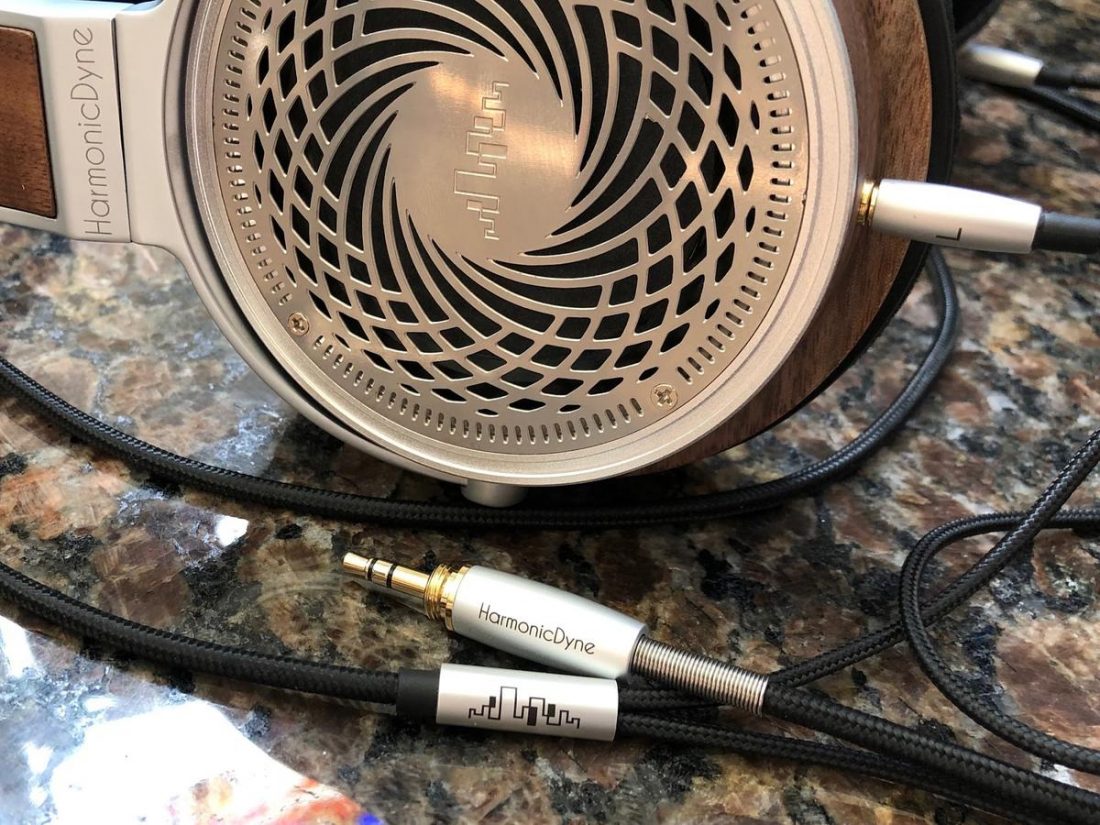
The cable is cloth-covered and features a silver metal splitter with 3.5 mm metal jacks on either end. The stereo TRS jack is threaded for a screw-on 6.3 mm adapter (which was not included with my review set). There are dual 3.5 mm mono jacks on the headphone end of the cable (it’s actually fairly similar to the Meze 99 Classics cable).
Build Quality
The build quality and materials of the Helios really stand out. This is not a pair of all-plastic, cheapo generic headphones. Real walnut wood is used for the ear cups and it embellishes both sides of the band. The cup gimbals and pivots are made out of beefy aluminum. Laser-cut stainless steel grills adorn the cup exteriors.
Things feel well-crafted and reasonably tough but there is some audible creakiness with the interior plastic of the headband when the band is flexed.
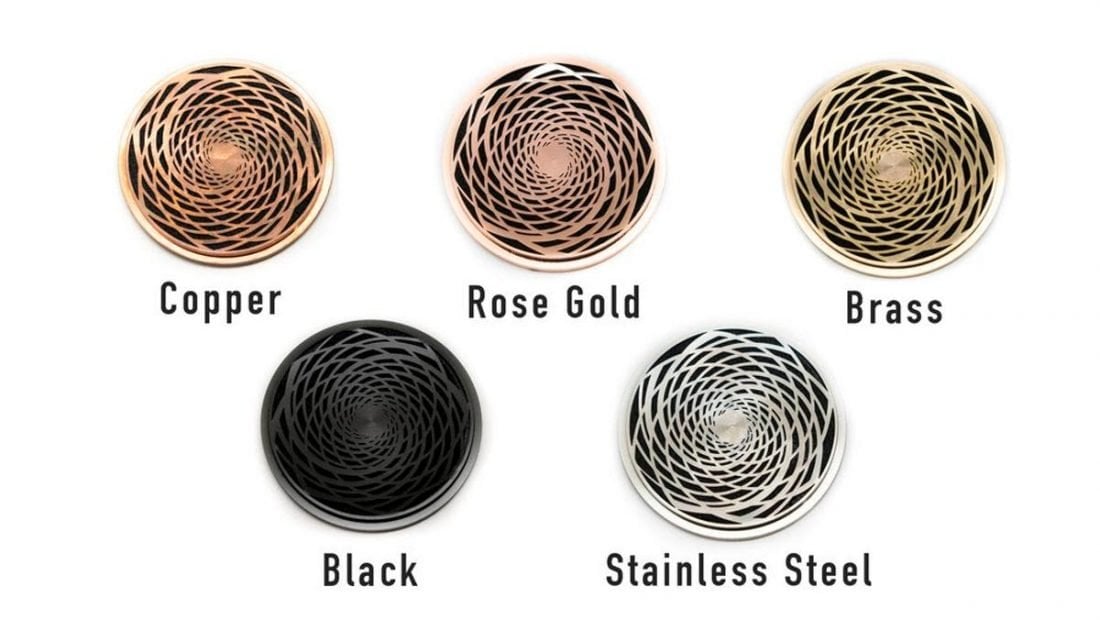
Sure, there is some plastic mixed in there around the spring steel band, and unfortunately, the stainless-steel grills are close, but not quite a perfect match to the aluminum, so things aren’t entirely impeccable. The promotional photos minimize the difference in the colors of the metals, but it is noticeable when viewed in person.
The HarmonicDyne logo appears to be a stylized skyline and is somewhat reminiscent of audio level meters as well. The logo is displayed on the center of the grills and on the cable splitter. It looks fine but it seems a bit large and busy for me.
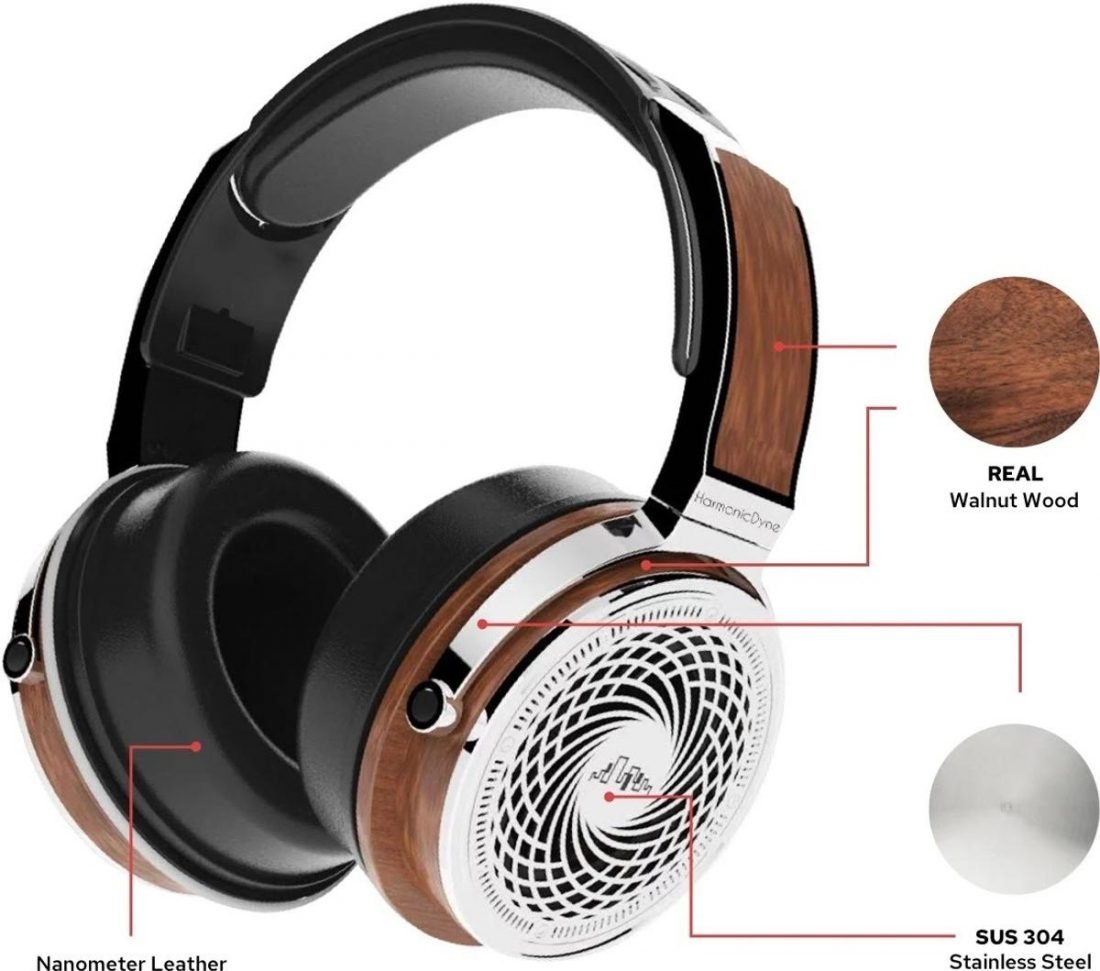
The fit and finish of the walnut cups is outstanding. Really gorgeous. The wood veneer on the sides of the band is an interesting choice, however. Reactions to the inclusion of wood veneer are varied (and as a result, it has been publicly maligned). Honestly, it’s a good match for the cups and I find it quite attractive. As they say, beauty is in the eye of the beholder.
Comfort
Comfort is a mixed bag. HarmonicDyne claims that long listening sessions will be “pleasurable” due to the “lightweight and soft-build design” yielding a “secure fit and cloud-like comfort”. Unfortunately, the reality doesn’t quite live up to the hyperbole.
The Helios is not crazy heavy (360g), but all that metal and wood add up to a substantial feeling pair of headphones. The headband initially has too tight a clamping force (I carefully stretched it out), and the padding on the inside of the band is minimal and only just sufficient to support the weight.
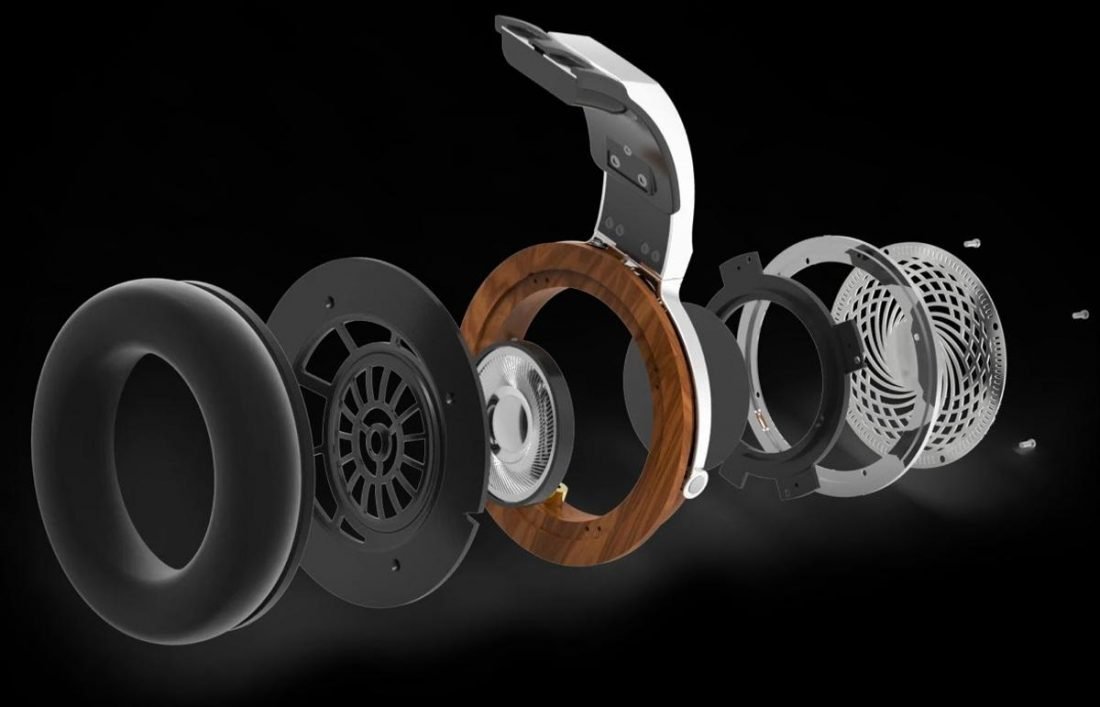
The earpads are large and round, but fairly shallow. If you are blessed with protruding ears, this will quickly become a comfort problem. Thankfully, my smallish, flat ears do not touch the inside of the cups. The velour material does get warm with extended use.
Some folks have experimented with many pad rolling combinations and have exclaimed the virtues of pairing ZMF Ori pads with the Helios, claiming greatly enhanced sound quality, width, extension, and punch. Backers of the Indiegogo launch have reportedly received emails saying that buyers will receive several different pairs of ear pads to encourage pad rolling to match the owner’s tastes. So that’s a plus!
Technology and Design
HarmonicDyne states they have sourced a German-made, 50mm composite diaphragm, dynamic driver for the Helios. They claim that the driver in “the Helios offer an extreme frequency response of 10Hz to 40kHz. Going beyond the audible range of the human ear, the dynamic range of the Helios ensures you will never miss any details of any song.”
Similar to some other headphone models from Sony, Stax, Beyerdynamic, and Sennheiser, the drivers in the Helios are positioned in front of the ear canal and angled backward. This is typically done to better emulate the way sound waves naturally contact the ears. In headphones such as the Sennheiser HD800, this is part of the combination that yields their legendary imaging and incredible sense of space.
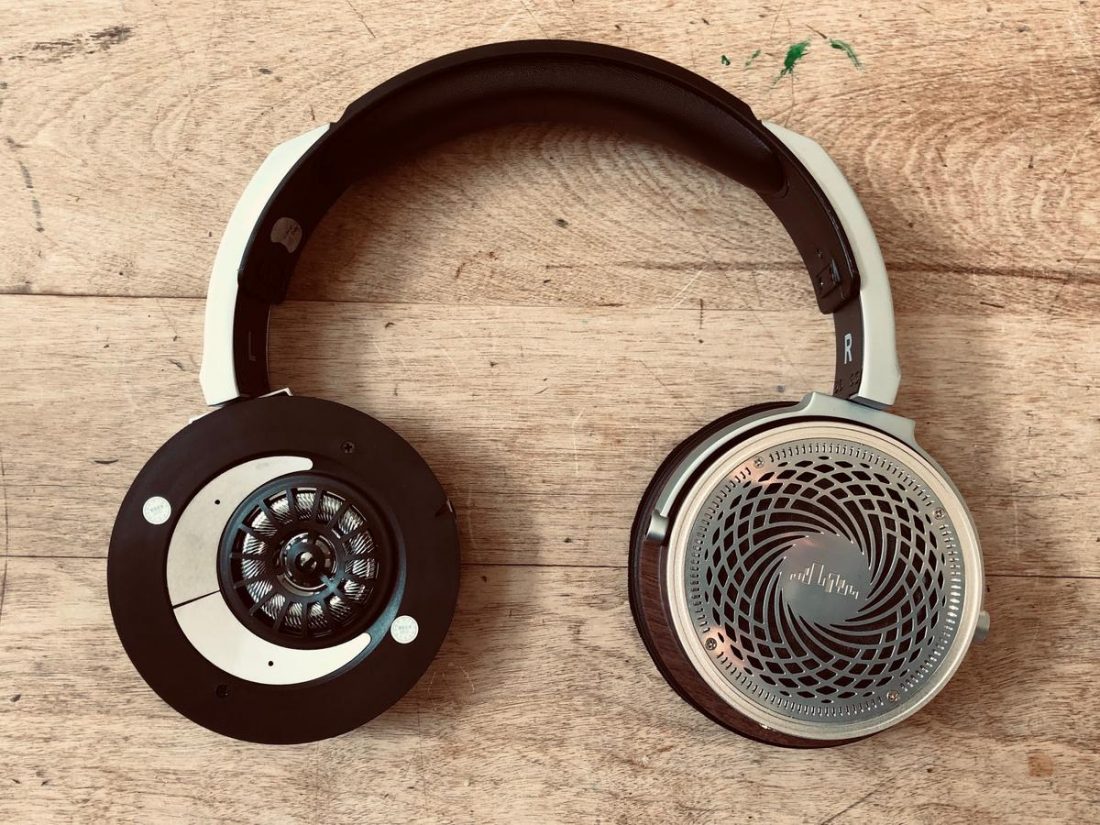
The drivers are mounted on a black plastic baffle with two thin white sound dampening pieces filling out the circular surface beneath the pads. This plastic piece is entirely hidden when the pads are in place, but is clearly a spot of cost-cutting, as it’s the ‘cheapest’ feeling part of the entire headphones.
Each cup is carved out of a single piece of solid walnut to create an (in HarmonicDyne’s words) “…acoustic chamber that resonates with luxurious timbre. We specifically chose solid walnut not only because of their beautiful appearance, but because walnut wood is known for is Mahogany-like warmth in the mids with the punchy and resonant bass like that of rosewood.”
So that leads us to the real question. Do the Helios sound as good as they look?

Audio Quality
I really didn’t know what to expect when I first popped the Helios on my head. They sounded immediately good. Bright. Clear. Lively. “Well dang”, I said to myself, “this is impressive!”
I tested the Helios directly from my iPhone, with an XDuoo XD05 Plus, and also connected to a Chord Mojo. The Mojo provides an additional benefit of being able to simultaneously connect two pairs of headphones. This makes A/B comparisons fairly easy once level matching is performed (using the LED colored buttons of the Mojo simplifies changing from one volume level and back again).
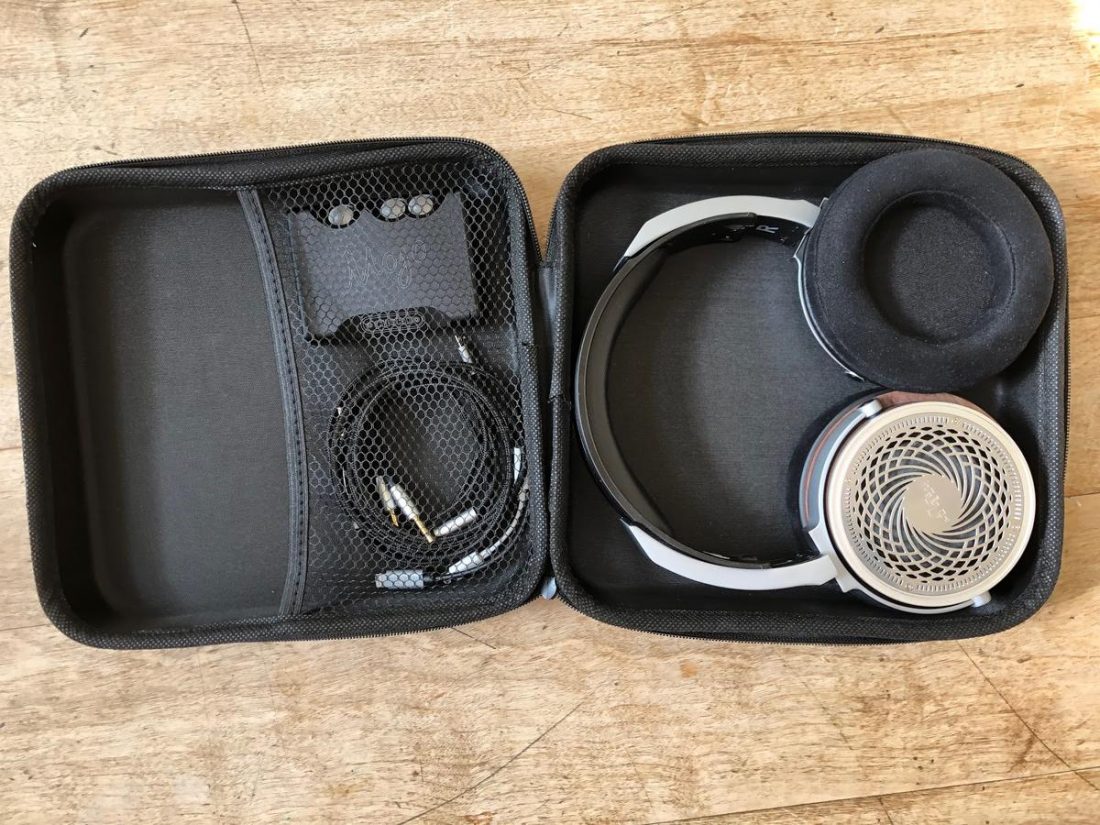
My very first impressions of the Helios were positive, however, it was through further side by side listening sessions (with the Sennheiser HD650) when weaknesses became apparent.
A lack of natural tonality becomes immediately obvious when listening to mid-centric music like Jack White’s outstanding Blunderbuss album. On a stripped-down track like Love Interruption, voices are both thinner and harsher in how they are presented. On busy tracks, the Helios becomes far more congested sounding than the HD650.
Overall, the Helios has a somewhat v-shaped sound signature, with good mid-bass and an overall bright and lively feel. HarmonicDyne states that the “…new custom drivers, matched with our expertise tuning make for an amazing sound. The custom driver cavity and open-back design provide acoustics that can parallel any studio recording room!”
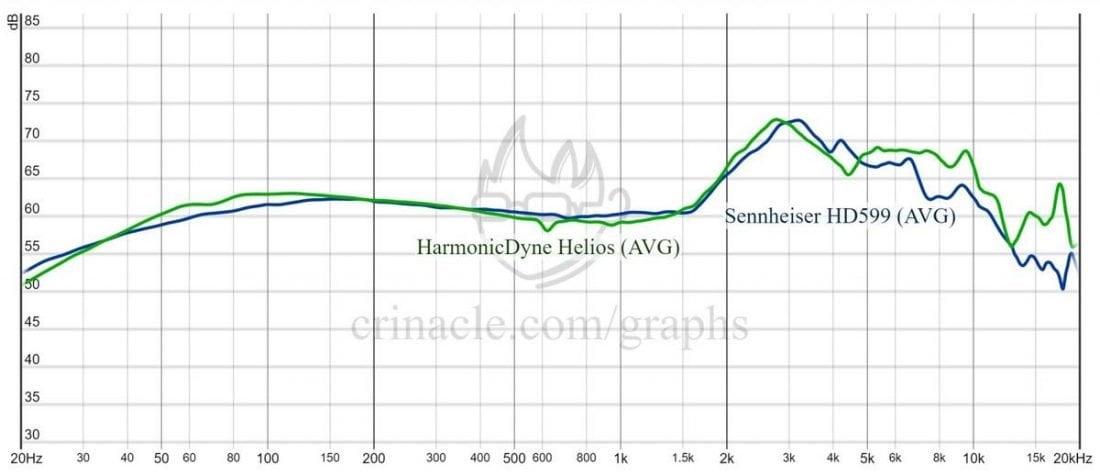
I don’t really agree with HarmonicDyne’s advertising claim that the “… Helios presents a natural, detailed and balanced sound…”. The Helios sound signature certainly has positive aspects, but ‘natural’ really isn’t one of them. However, they are immediately engaging, with a fun, warm, bassy signature and accentuated high end. Lots of folks will really enjoy them.
Bass
HarmonicDyne claims that they “…tuned the bass to be very precise yet deep enough to leave a satisfying rumble. The speed of the bass allows our transparent mids to shine through for those smooth vocals.”
The Helios has a slightly elevated mid-bass with rolled-off sub-bass. This gives a fun and punchy feel to the music, but depending on the song it can get less controlled than I like. Overall the bass is fun-sounding but not really the best at precision or resolution.
The mid-bass warmth does seem to extend a bit into the midrange and may be contributing to some of the congestion and lack of natural tone that I hear in this area.
Midrange
It’s that lack of natural tone that I struggle with the most when critically reviewing the Helios. When listening to bare-bones, voice-centric tracks, the Helios does not have a natural-sounding timbre. Again, this is mainly noticeable when comparing to a headphone such as the HD650 (which to be fair is known for legendary midrange performance).
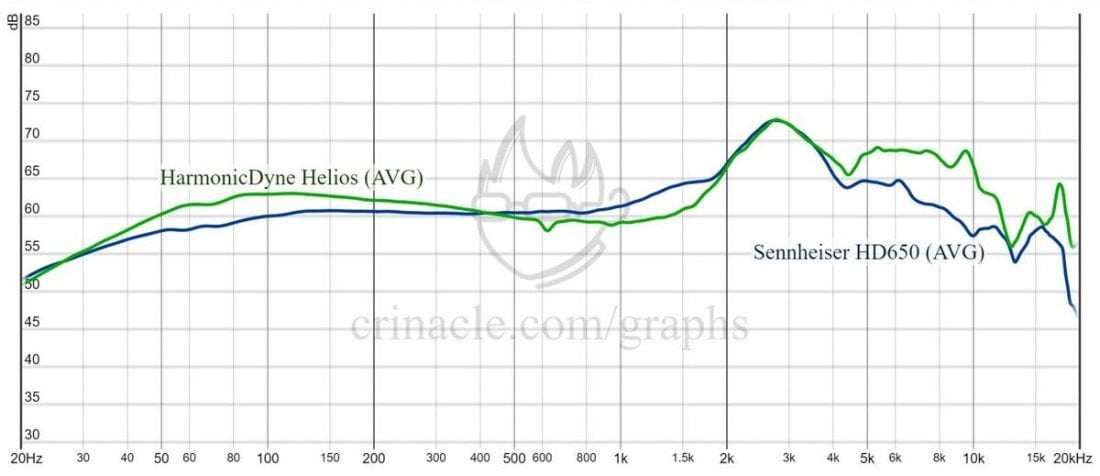
When songs get busier or are mid-frequency focused, the midrange can really start to lose proper coherence. This is less obvious at low volume than at higher volume levels. When played loudly, the overall sound becomes shouty. For me, the midrange is definitely the weak spot for the Helios.
Treble
On the other hand, higher frequencies are reproduced admirably well by the Helios. The somewhat boosted high-end is a respectable complement to the enhanced mid-bass, and it remains free of harshness or sibilance. It is this bright, clear sound that makes the Helios immediately enjoyable on first listen.
Treble is often described in visual terms, and it really does ‘shine’ on the Helios.
Conclusion
Thank you to Linsoul for providing a review pair of Helios headphones. You can purchase the HarmonicDyne Helios from Indiegogo.
So, did Linsoul and HarmonicDyne meet their goals of “…a true marriage of stylistic design and optimal acoustics”? ‘Style’ was delivered – no question. ‘Optimal acoustics’ is perhaps debatable.
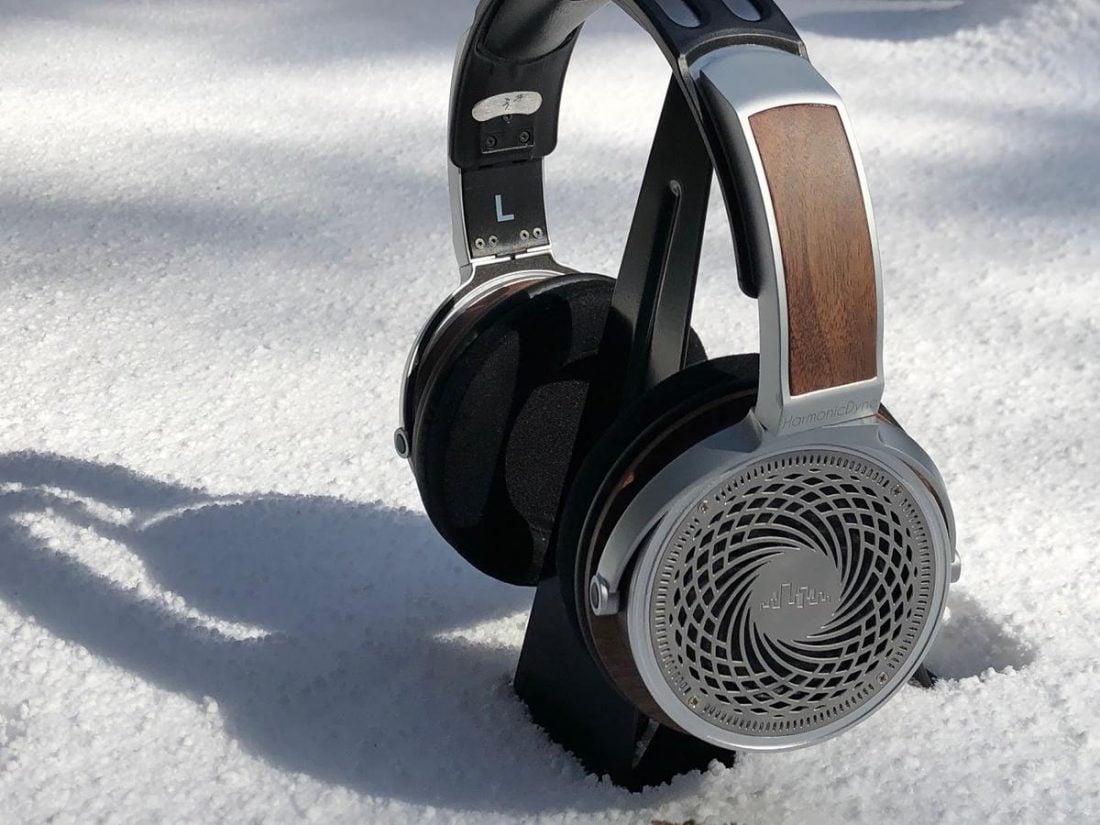
This pre-launch time is a crucial point in a product’s development – near release, but not yet available for purchase. This is where momentum is built, and initial sales are cemented. Only a few lucky folks such as myself have had the opportunity to spend time with the Helios.
Initial reviewer impressions seem to be mixed. Anything from near-hysterical effusive adoration, to disappointed disillusionment. Are the Helios low-res, low-fi, not-so-good, or are they incredible sounding and the equal to headphones costing several times as much?
These are not $1000, $500, or even $250 headphones. To be honest, the Helios doesn’t sound, feel, or quite look the part of the best examples in these broad categories. So, I caution those about to board the hype train, the Helios is entirely decent headphones, but they aren’t quite the giant killers that they want (or some have made them out) to be.
There is no real magic going on here, but rather a successful formula at work. Vastly improved Chi-Fi manufacturing plus ever-escalating bang-for-the-buck, results in an unending flood of attractively-priced and good-sounding headphone audio products coming from China. The Helios is a solid offering, but I don’t feel they quite set an unimpeachable high-water mark.
The Sennheiser HD650 is a better sounding headphone. The release of the Drop HD6XX variant means it is priced the same as the Helios’ eventual retail price ($200 USD). There is a serious caveat here though, as the HD650 really does require adequate amplification to sound its best, while the Helios can be easily driven by most devices.
The Sennheiser HD58X or HD599 are very worthy rivals around this price point. However, if style factors heavily in your decision making (as Linsoul would like it to) then the HarmonicDyne Helios offers something that the Sennheiser options do not. These are posh headphones, made from premium materials and they feature a unique high-end look.
So, I find myself somewhere in the middle. The value proposition of the Helios will ultimately depend on that final retail price. At $150, these are a serious contender, but the competition gets mighty stiff at the $200 price point. I look forward to any future HarmonicDyne headphone offerings to see what they have learned with this strong first attempt.
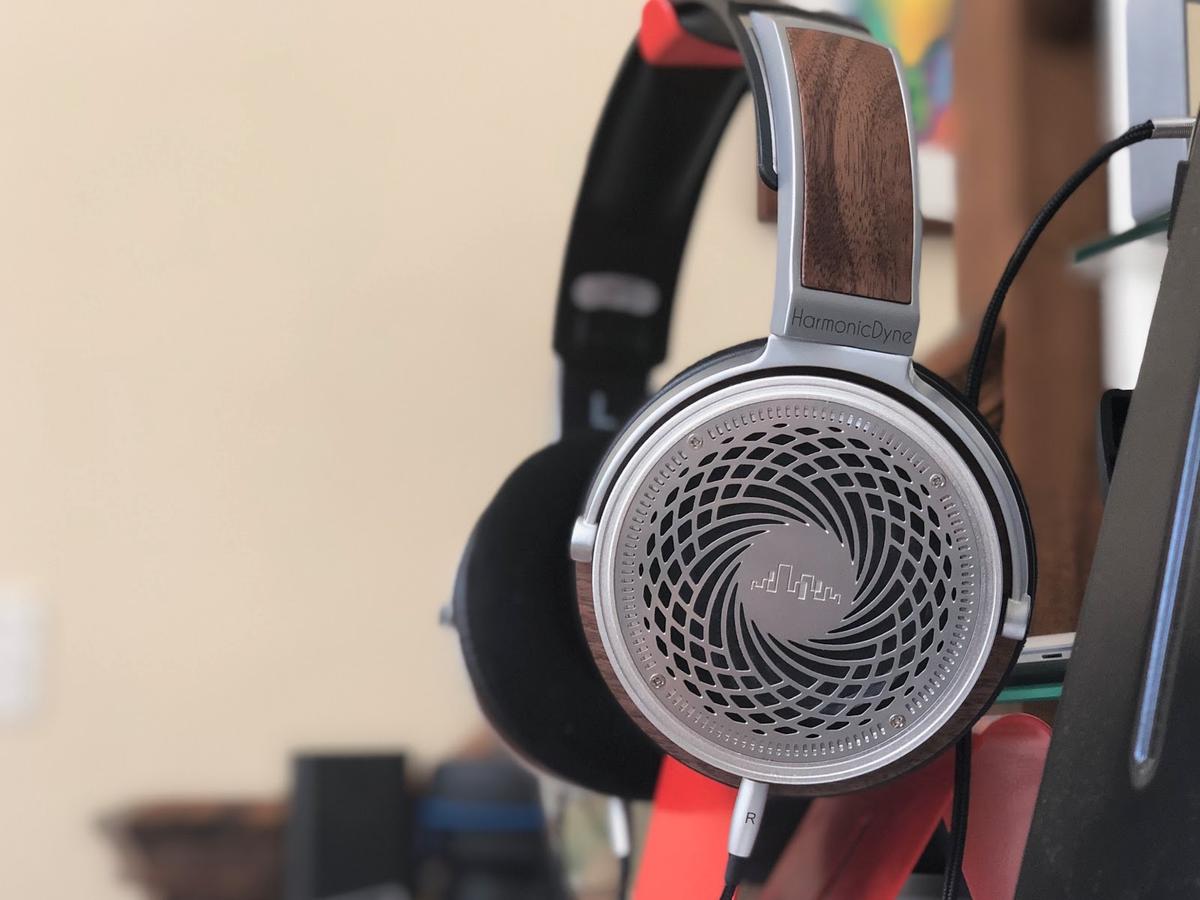
I know this is an old review but I’m looking at getting a pair of the Zeus (as a possible upgrade)
DIY fix for the Helios midrange….. remove the SS laser cut backs and apply 1/4 x 1 1/2 in. strips of dynamat in an x pattern on the inside then re-assemble and enjoy.
I could not get over the problems with the midrange until I tapped the back with a finger while listening to a quiet passage.
I am still considering the Zeus but need a listen first.
Thanks for the tuning tip!